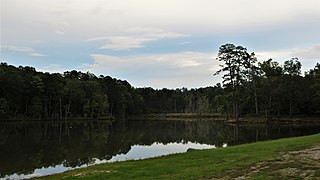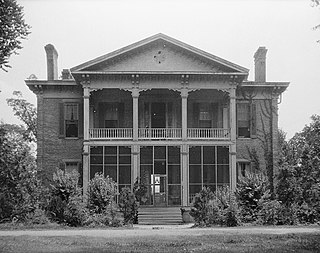
Washington County is a county located in the southwestern part of the U.S. state of Alabama. As of the 2010 census, the population was 17,581. The county seat is Chatom. The county was named in honor of George Washington, the first President of the United States. It is a dry county, with the exception of Chatom.

Washington County is a county located in the U.S. state of Mississippi. As of the 2010 census, the population was 51,137. Its county seat is Greenville. The county is named in honor of the first President of the United States, George Washington.
Strand Theatre or Strand Theater may refer to:

Legion State Park is public recreation area located on the north edge of the city of Louisville, Mississippi, and adjacent to Tombigbee National Forest. As Legion State Park Historic District, the state park entered the National Register of Historic Places in 1998. It is managed by the Mississippi Department of Wildlife, Fisheries and Parks.

Tougaloo College is a private, historically black, liberal arts college in Tougaloo, Mississippi. It is affiliated with the United Church of Christ and Christian Church. Originally established in 1869 by New York–based Christian missionaries for the education of freed slaves and their offspring, from 1871 until 1892 the college served as a teachers' training school funded by the state of Mississippi. In 1998, the buildings of the old campus were added to the National Register of Historic Places.

Tombigbee State Park is a public recreation area located off Mississippi Highway 6 approximately 5 miles (8.0 km) east of Tupelo, Mississippi. The state park surrounds 90-acre (36 ha) Lake Lee and is named for the nearby Tombigbee River.

Wall Doxey State Park is a public recreation area located off Mississippi Highway 7, approximately 7 miles (11 km) south of Holly Springs, Mississippi. The state park is centered around 60-acre (24 ha) Spring Lake.

Holmes County State Park is a state park in the U.S. state of Mississippi located off U.S. Route 51 approximately 4 miles (6.4 km) south of Durant. The park features two lakes, 45-acre (18 ha) English Lake and 14-acre (5.7 ha) Odum Lake.

Roosevelt State Park is a public recreation area located off Interstate 20 on the southwest side of Morton, Mississippi. The state park surrounds 150-acre (61 ha) Shadow Lake at the western edge of Bienville National Forest, between Jackson and Meridian. It is managed by the Mississippi Department of Wildlife, Fisheries and Parks.

Erwinna is an unincorporated community in Tinicum Township, Bucks County, Pennsylvania, United States, with a zip code of 18920. It is located approximately 40 miles (64 km) north as the crow flies of Center City Philadelphia and has an area code of 610.

Wayside is an unincorporated community in Washington County, Mississippi, United States.

The Hiram Price/Henry Vollmer House is a historic building located on the Brady Street Hill in Davenport, Iowa, United States. It was listed on the National Register of Historic Places in 1983. The home is named for two members of the United States House of Representatives who lived in the house, Hiram Price and Henry Vollmer, who both represented Iowa's 2nd congressional district. The building is now a part of the campus of Palmer College of Chiropractic where it houses the Office of Strategic Development.

Lake Washington is an oxbow lake in Washington County, Mississippi, United States.

Mount Holly was a historic Southern plantation in Foote, Mississippi. Built in 1855, it was visited by many prominent guests, including Confederate President Jefferson Davis. It was later acquired by ancestors of famed Civil War novelist Shelby Foote, who wrote a novel about it. It burned down on June 17, 2015.

The Junius R. Ward House is a historic house and former Southern plantation in Erwin, Mississippi.

Foote is an unincorporated community in Washington County, Mississippi, United States. Variant names include Colmere and Dudley.

The Warren-Erwin House is a historic house in Natchez, Mississippi, USA.

The Dubuque Freight House is a historic building located in Dubuque, Iowa, United States. Built by the Chicago, Burlington and Northern Railroad (CB&N) in 1901, this was the third and last freight house built by a railroad in the Ice Harbor area. The other two facilities were built by the Illinois Central Railroad (1872) and the Chicago, Milwaukee and St. Paul Railroad (1874). These other two railroads were older, larger, and monopolized the bridge and tunnel that crossed the Mississippi River. The CB&N was fortunate that their freight house was located along the water's edge in that the river boats could tie up next to the building and load and unload cargo, and the railroad put box cars on ferries that docked in the Ice Harbor. The Dubuque Boat and Boiler Works were headquartered on the west end of the facility for 20 years beginning in 1952. Founded in 1852 as the Iowa Iron Works, they provided engines, boilers and other equipment for river boats, and water craft for the United States Navy, United States Coast Guard, and the United States Army Corps of Engineers. The building was listed on the National Register of Historic Places in 1979. It is now a part of the National Mississippi River Museum & Aquarium.

The Davenport Downtown Commercial Historic District is a nationally recognized historic district located in the central business district of Davenport, Iowa, United States. It was listed on the National Register of Historic Places in 2020. At the time of its nomination it consisted of 43 resources, which included 33 contributing buildings, one contributing structure, and nine non-contributing buildings. In addition, the district also contains 33 buildings that are individually listed on the National Register. This historic district is bordered by four other districts: the Crescent Warehouse Historic District and the Davenport Motor Row and Industrial Historic District on the east, the Hamburg Historic District to the northwest, and the West Third Street Historic District on the west.


















